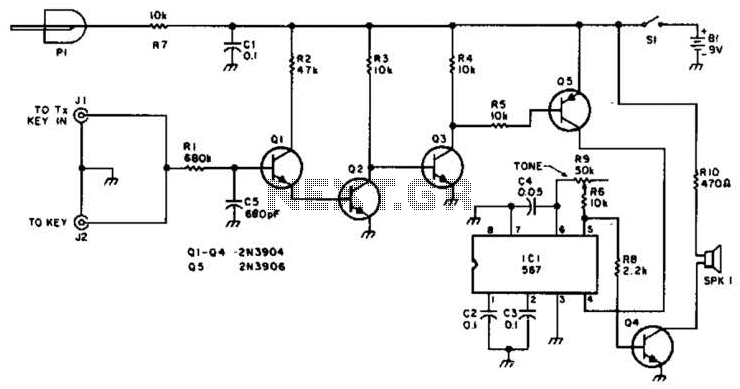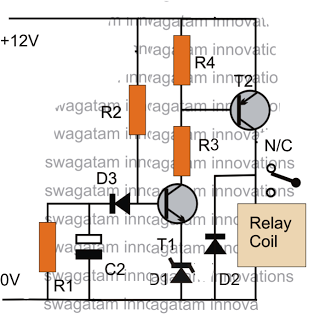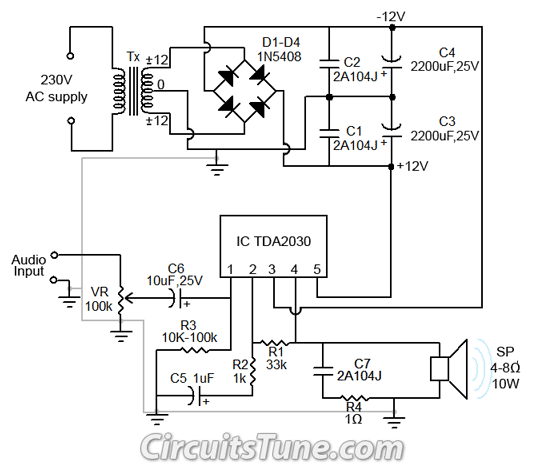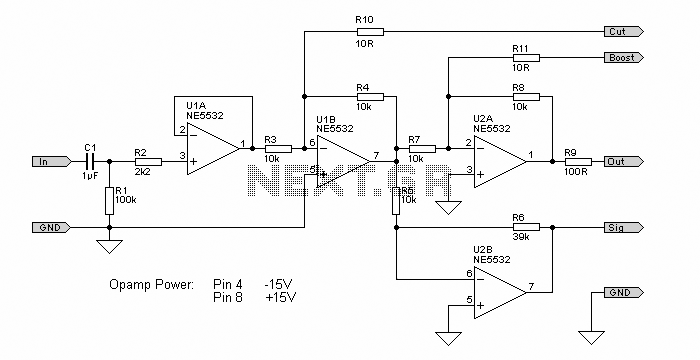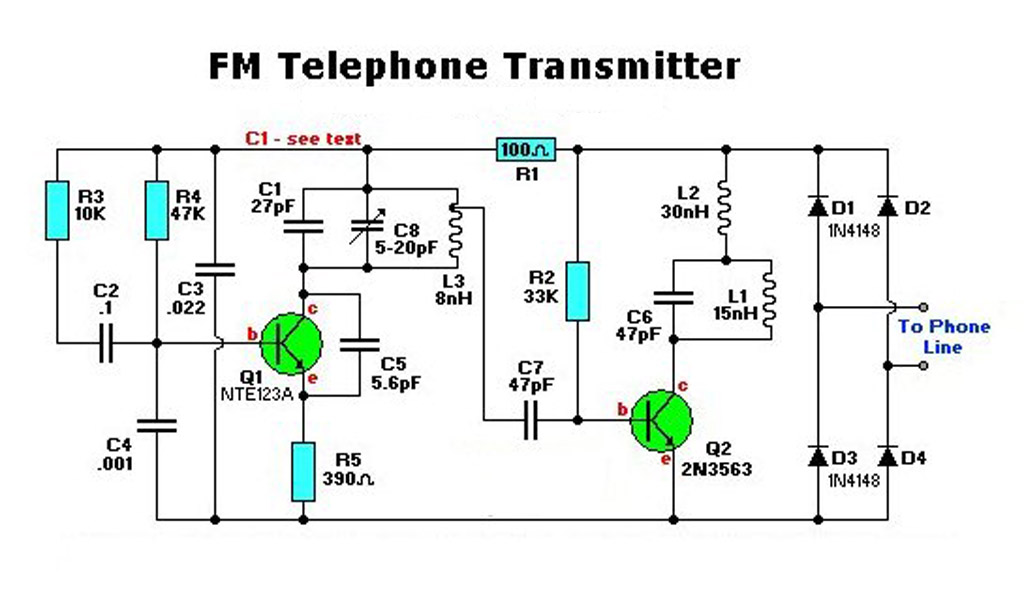
Touching monolithic flasher - buzzer circuit diagram
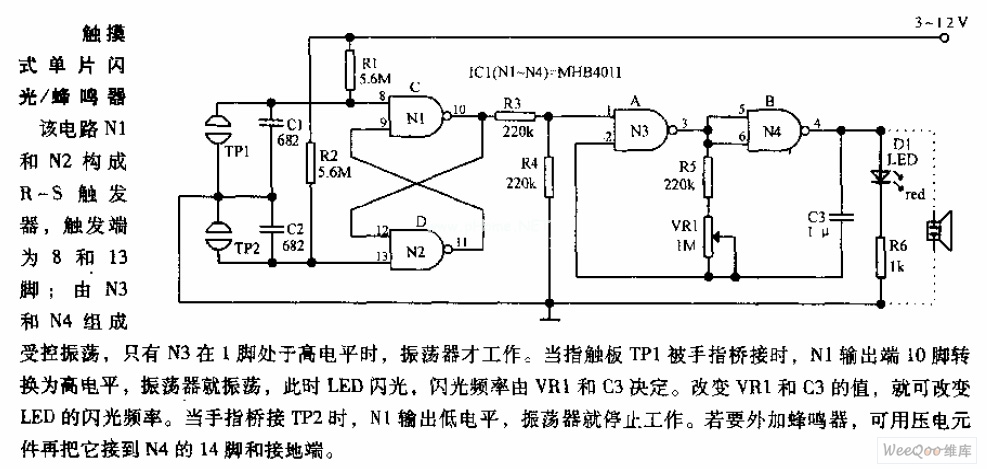
In the circuit, N1 and N2 form the RS flip-flop, with the trigger inputs located at pins 8 and 13. N3 and N4 create a controlled oscillator that operates only when pin 1 of N3 is high. When the finger touches the pad TP1, the output pin of N1 switches to a high level, causing the oscillator to activate, which in turn makes the LED flash. The frequency of the flashing is determined by...
The circuit utilizes a combination of logic gates and oscillators to create a simple touch-sensitive LED flasher. The RS flip-flop, composed of two NAND gates (N1 and N2), is responsible for storing the state of the touch input. The inputs at pins 8 and 13 serve as the trigger points for the flip-flop; when one of these inputs receives a high signal, the output at pin Q will change state.
The controlled oscillator, formed by N3 and N4, is a key component that generates a square wave signal. This oscillator is enabled only when the output of the RS flip-flop (pin Q of N1) is high. The configuration of N3 allows it to function as an astable multivibrator, producing a continuous oscillation that drives the LED. The frequency of oscillation, and thus the flashing rate of the LED, is influenced by the values of the resistors and capacitors connected to N3.
The touch-sensitive pad TP1 acts as a manual input device. When a finger bridges the pad, it creates a path to ground or to a high voltage, depending on the circuit design. This action triggers the RS flip-flop, which changes state and enables the oscillator. The resulting output is a visually observable LED flash, providing immediate feedback to the user.
The design can be further enhanced by adjusting component values to modify the flashing frequency, adding additional LEDs for visual effects, or incorporating debounce circuitry to ensure stable operation when the touch pad is activated. Overall, this circuit exemplifies a straightforward application of digital logic and oscillator principles to create an interactive electronic device.In the circuit, N1, N2 constitute the RS flip-flop, and the trigger end is pin 8 and 13; N3, N4 form the controlled oscillator, only when N3`s pin 1 is high, the oscillator works. When the finger touching pad TP1 is bridging, N1 output`s pin turns to high level, the oscillator will oscillate, then the LED flashes, and the flash frequency is determined by..
🔗 External reference
The circuit utilizes a combination of logic gates and oscillators to create a simple touch-sensitive LED flasher. The RS flip-flop, composed of two NAND gates (N1 and N2), is responsible for storing the state of the touch input. The inputs at pins 8 and 13 serve as the trigger points for the flip-flop; when one of these inputs receives a high signal, the output at pin Q will change state.
The controlled oscillator, formed by N3 and N4, is a key component that generates a square wave signal. This oscillator is enabled only when the output of the RS flip-flop (pin Q of N1) is high. The configuration of N3 allows it to function as an astable multivibrator, producing a continuous oscillation that drives the LED. The frequency of oscillation, and thus the flashing rate of the LED, is influenced by the values of the resistors and capacitors connected to N3.
The touch-sensitive pad TP1 acts as a manual input device. When a finger bridges the pad, it creates a path to ground or to a high voltage, depending on the circuit design. This action triggers the RS flip-flop, which changes state and enables the oscillator. The resulting output is a visually observable LED flash, providing immediate feedback to the user.
The design can be further enhanced by adjusting component values to modify the flashing frequency, adding additional LEDs for visual effects, or incorporating debounce circuitry to ensure stable operation when the touch pad is activated. Overall, this circuit exemplifies a straightforward application of digital logic and oscillator principles to create an interactive electronic device.In the circuit, N1, N2 constitute the RS flip-flop, and the trigger end is pin 8 and 13; N3, N4 form the controlled oscillator, only when N3`s pin 1 is high, the oscillator works. When the finger touching pad TP1 is bridging, N1 output`s pin turns to high level, the oscillator will oscillate, then the LED flashes, and the flash frequency is determined by..
🔗 External reference
Warning: include(partials/cookie-banner.php): Failed to open stream: Permission denied in /var/www/html/nextgr/view-circuit.php on line 713
Warning: include(): Failed opening 'partials/cookie-banner.php' for inclusion (include_path='.:/usr/share/php') in /var/www/html/nextgr/view-circuit.php on line 713
